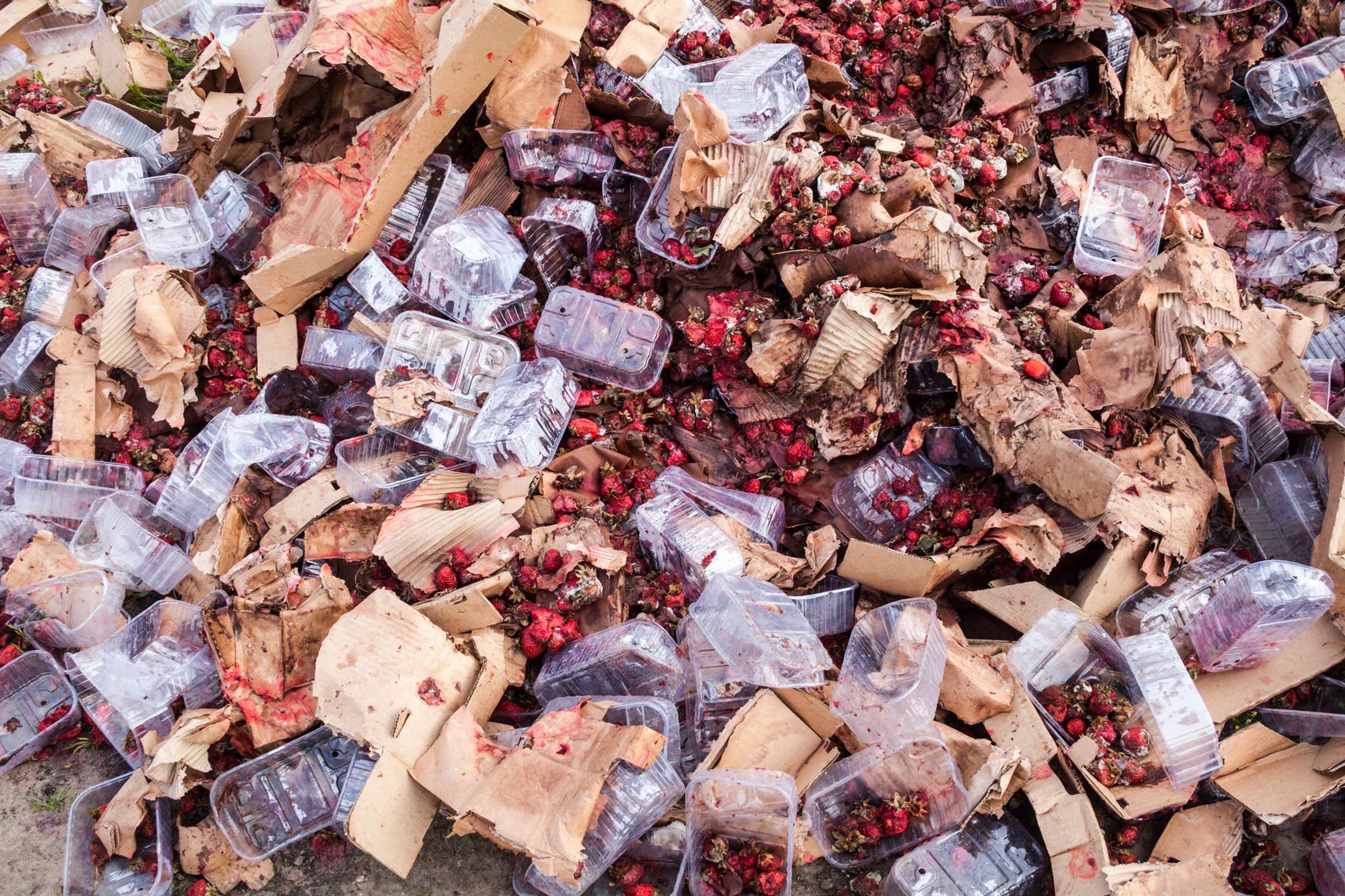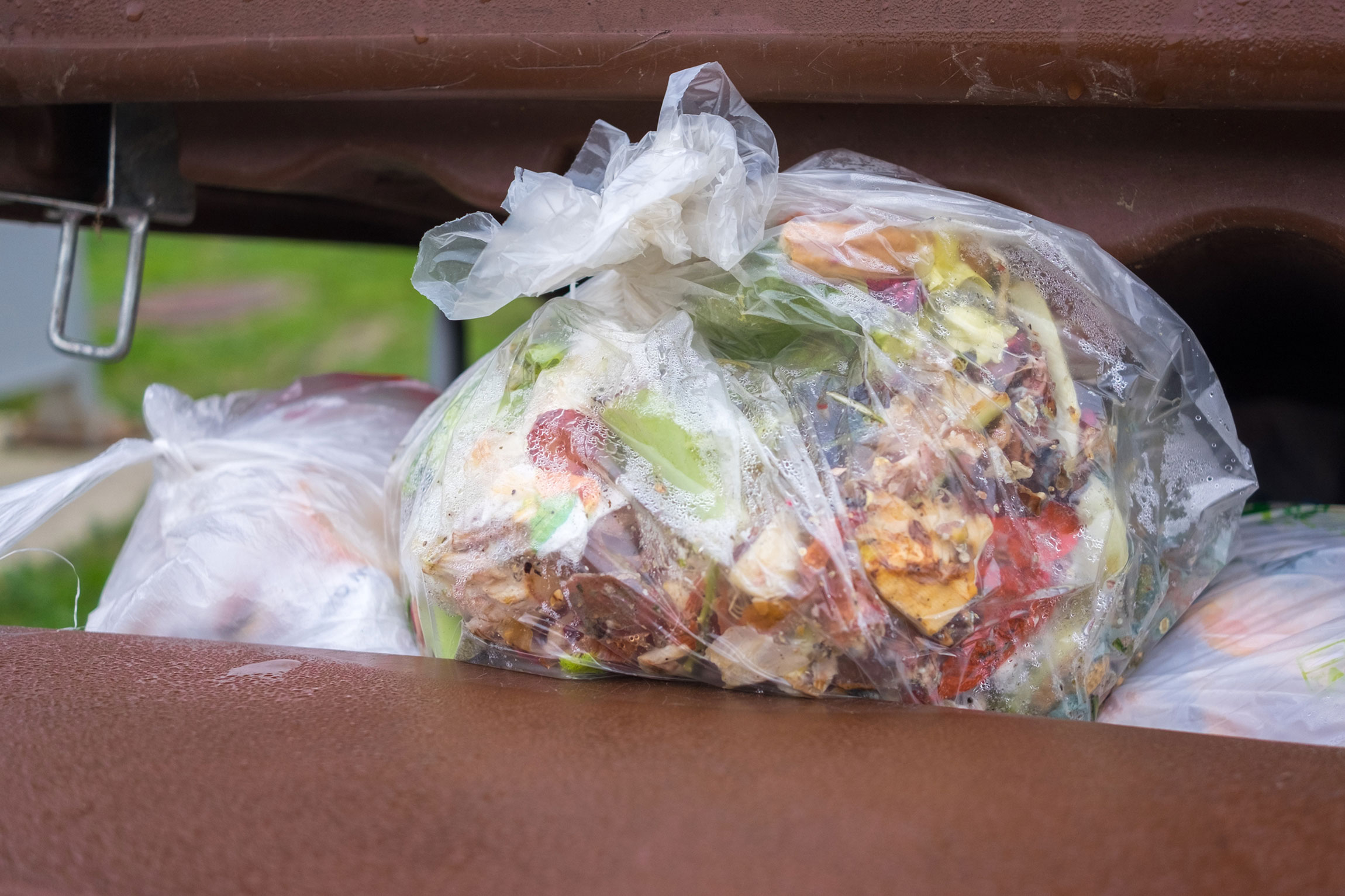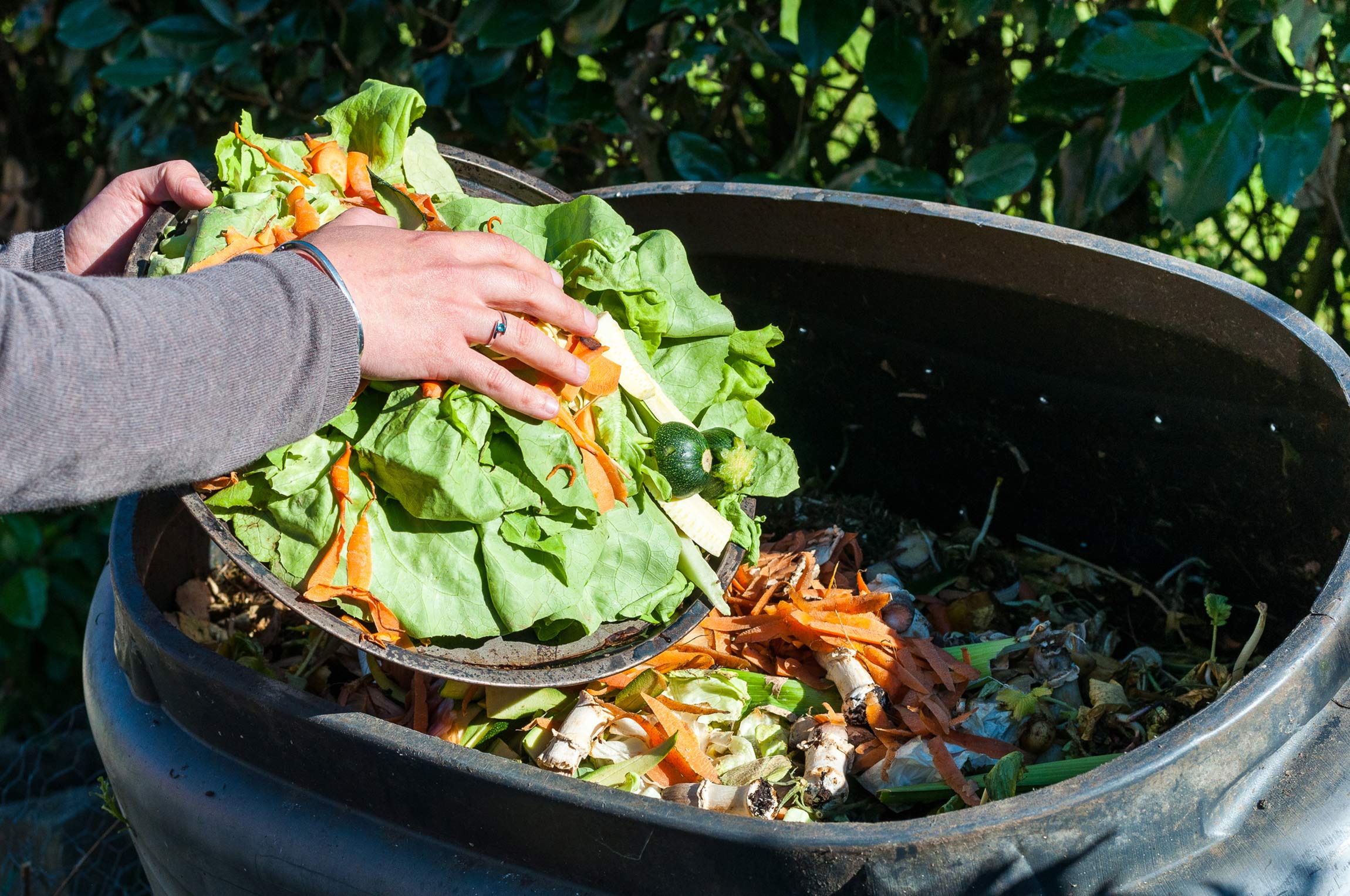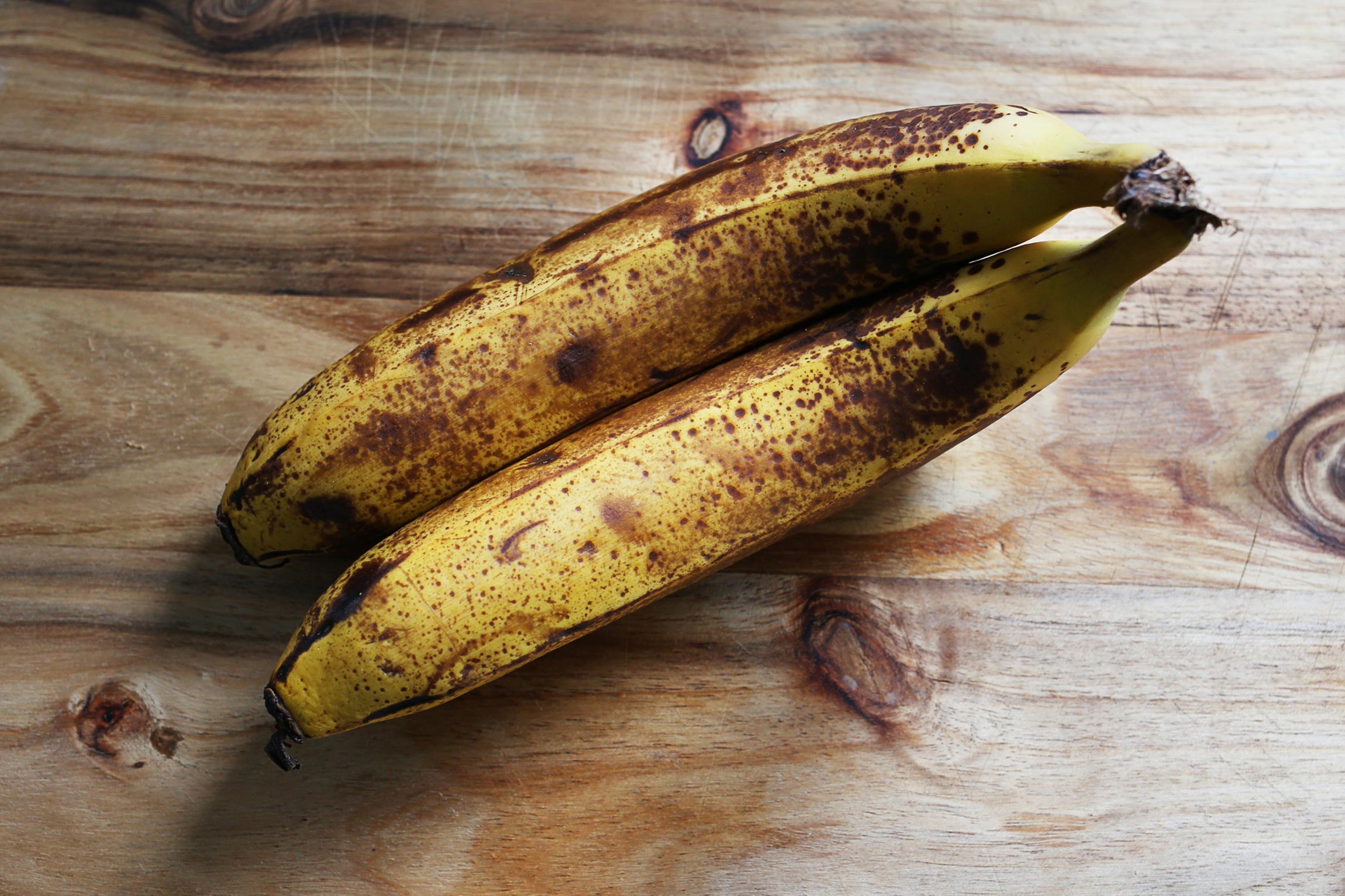Learn why food waste is a major problem in the U.S. and worldwide, what’s being done about it, and ways you can help reduce food waste.
Food is best when it makes it to our mouths so we can enjoy it. But, all too often, food is wasted.
Food waste is happening across all stages of the food supply chain, from growers throwing out “ugly” produce to consumers allowing fruit to rot at the back of the fridge.
In the U.S., almost half of our food is going to waste! According to a groundbreaking 2012 report from the Natural Resources Defense Council, America is losing up to 40% of its food — which is more than 1,250 calories per person per day.
And globally, the Food and Agriculture Organization of the United Nations estimates that 30% of all food produced for humans worldwide (more than 1 billion tons) is thrown away each year. That’s enough to feed three billion people!
Not only is this problem vast; it’s also growing. Americans are now squandering more food than ever. In the U.S., people waste 50% more food today than in the 1970s.
And food waste is increasing worldwide as well. For example, in several Chinese cities, such as Beijing and Shanghai, food waste now makes up 50 to 70% of municipal solid waste.
Wasting food not only affects consumer finances, but it also impacts the global economy, the environment, and global efforts for hunger relief.
So what can be done to help solve this massive problem? And how can you help?
The Dirty Details on Food Waste

What causes food waste?
There are numerous factors. For example, oversized restaurant servings lead to excessive waste in fast food restaurants and sit-down eateries. Fruits and vegetables that are considered too small, too large, or visually unappealing are tossed out by retailers. And when crops are no longer profitable to harvest, farmers often leave fields to rot.
On the consumer side, a lot of confusion exists about the freshness dates on packaged foods, and people sometimes throw out items prematurely. Most food that gets wasted comes from households allowing food to go bad.
By Wasting Food, We’re Throwing Out A Lot of Nutrition
Not only is food not being used, but a lot of nutrients are lost as well.
Fruits and vegetables (including roots and tubers) are being sent to landfills more than any other type of food.
All in all, we’re throwing out a lot of nutrients that people need to nourish themselves and be healthy — when eating them could help lead to lower rates of disease and other health challenges. (In particular, Americans under-consume fiber, and the fiber we waste through discarded food could fill the gap for over 200 million adult women.)
Food Waste Is a Tremendous Economic Waste
When food is wasted, it’s like burying money in the landfill.
According to the Food Loss & Waste Protocol, about 940 billion dollars are lost each year globally, due to the huge level of inefficiency in food distribution and consumption.
Also, excessive demand for food we don’t even eat drives up prices, making food more expensive for everyone, including the poor.
But as bad as the problem is — that’s also how much better things could be with a change! In 2017, the World Resources Institute analyzed 700 companies across a variety of food industries in the United States and 16 other countries. They found that for every dollar, on average, the companies spent cutting food waste, they saw a $14 savings in operating costs.
On a more personal level, individuals and families could have more money in their pockets if they didn’t waste food. In Britain, each family discards, on average, 700 pounds, or $1,170, worth of food each year. That could provide for more than 250 pounds of fresh blueberries, at $4 per pound!
When Food Is Wasted, It’s Bad for the Environment

Food is the number one addition to landfills. But it may seem like throwing food into landfills is no big deal. After all — food is biodegradable, right?
It’s true that food itself is biodegradable, but it’s usually in plastic garbage bags and buried deep beneath other waste. This dark, cramped, and oxygen-starved environment drastically slows the rate of decomposition.
Because the food in landfills is deprived of oxygen (and insects), it barely breaks down. And much worse, as it slowly decays, this food releases climate-damaging methane gas.
According to the U.S. Environmental Protection Agency, methane is 25 times more harmful than carbon dioxide over a 100-year period, and landfills account for 16% of all methane emissions in the U.S.
When the Food and Agriculture Organization of the United Nations (FAO) analyzed food and climate change, the organization concluded that if food waste were its own country, it would be the third-largest emitter of greenhouse gases.
In addition, for the food encased in plastic, the nutrients may not return to the soil for many hundreds of years.
While a few landfills have implemented composting, most of them still don’t do it.
If food waste were its own country, it would be the third largest emitter of greenhouse gases.
Throwing food away also wastes resources used in production including land, water, energy, labor, and capital.
According to a 2013 analysis by the FAO, the land devoted to producing wasted food would be the second-largest country in the world.
Producing more food than we need also places croplands under pressure to over-produce, fueling increased use of pesticides and unsustainable practices that increase yield but cause long-term damage to soil, water supply, and sometimes even to food safety.
Could Reducing Food Waste Help Solve World Hunger?
As a child, you may have heard this as you pushed food around your plate: “Eat all your food because there are starving people in the world.”
The truth is, the world produces enough food to feed every human on this planet — and then some. We waste a lot of this food directly by sending it to landfills.
We also waste enormous amounts of grain and soy by feeding them to livestock in feedlots and modern “factory farms.” Producing one pound of feedlot beef requires about 12 pounds of feed input. For pigs, it’s about seven pounds, while for chickens, it’s at least four.
The world produces enough food to feed every human on this planet — and then some. We waste a lot of this food directly by sending it to landfills.
The reality is that just stopping food waste is no guarantee that more food will reach the people who don’t have enough money to buy it.
But one thing is certain: Every pound of food we use for feeding landfills or livestock, instead of people, is a pound of food that definitely won’t be helping the world’s hungry.
And if we reduce demand, we can lower the price of food. We won’t be perpetuating a global system in which the rich eat meat and feed landfills, while the poor struggle to eat at all.
What’s Being Done About Food Waste in America?
Recent years have seen countries, organizations, and companies making strides towards reducing food waste.
Here’s some of what’s being done in the United States:
- In September of 2015, the United States Department of Agriculture (USDA) and the EPA announced a goal to cut food loss and waste in half by the year 2030 — which is in line with UN Sustainable Development Goals.
- In 2016, the U.S. Department of Agriculture issued new guidance to standardize food date labels. The guidelines encourage producers and retailers to use a “Best if Used By” date label, so consumers are clear that these foods are still edible past that date (as long as they don’t show signs of spoilage).
- The Food Donation Connection is an organization that helps companies “responsibly discard surplus foods.” Since 1992, it has coordinated the donation of more than 400 million pounds of prepared food from more than 15,000 restaurants.
- States and cities are taking action, too. California, Colorado, Iowa, Kentucky, Missouri, Oregon, South Carolina, Virginia and the District of Columbia offer state tax credits for food donations. And a new law that went into effect in Austin, Texas, on October 1st, 2018, now requires restaurants to dispose of food waste responsibly.
Progress is being made, but there’s much more to be done if we want to reduce food waste in meaningful ways.
What’s Happening Around the World to Reduce Wasted Food?
Other countries are also leading the charge to cut back on food waste.
Here are some inspiring developments:
- In France, a 2016 law banned grocery stores from throwing away any edible food. Failing to follow the law can result in a $4,500 fine — every single time. And it’s reportedly working. The nation’s food bank network, which serves 5,000 charities, now gets almost half of its stock from grocery outlets.
- Britain’s biggest grocery chain, Tesco, recently decided to get rid of “best before” labels on fruits and veggies to keep consumers from throwing them away prematurely.
- Germany has an ambitious goal of halving food waste by 2030. One strategy is to use smart packaging that can inform consumers when food is no longer safe to eat.
- A chef in Toronto, Canada, has come up with a creative solution: a pay-what-you-can grocery store, bakery, and cafe that sells rescued produce and other goods. Volunteers run the store, and any food that’s left over gets donated to a nearby homeless shelter. Called The Feed It Forward Grocery Store, it’s diverting about 500 pounds of food per day from landfills.
These are all exciting ideas, but the best opportunity may be what you can do.
How Can You Help Stop Wasting Food?

There are many easy things you can do to help cut back on food waste. Here are 17 ideas:
#1 Eat More Plants
Because cycling grain and soy through livestock is inherently wasteful, industrial meat, dairy, and egg production drive a great deal of waste. When you choose to avoid factory farms and eat lower on the food chain, you are making a huge impact.
According to a 2017 report published in the peer-reviewed journal Faunalytics, a shift to a vegetarian or vegan diet would have about the same impact as erasing all food loss at the retail and consumer level.
#2 Understand Dates on Food Labels
Food labels can be confusing. Different phrases have different meanings, and most food is still good to eat as long as it doesn’t show signs of spoilage (an off odor, flavor, or texture).
To help clear things up, here’s what each term means, according to definitions from the USDA:
- “Best if Used By / Before” refers to when a product will be of best flavor or quality. It’s not a purchase or safety date.
- “Sell-By” tells the store how long to display the product for sale (for the purposes of inventory). It’s not a safety date.
- “Use-By” is the last date recommended for the use of the product while at its best quality. It’s not a safety date, except when used on infant formula.
#3 Plan Ahead
Meal planning is one of the best ways to cut back on food waste and actually use everything you buy.
You may want to spend time on the weekend planning for the week ahead. Decide what you’ll cook, when, and how many times you might eat out. Make a grocery list based on what meals and recipes you want to create.
And if you’re nearing the end of the week and still have some unused veggies in the fridge, it might be time to bring out the steamer and cook them up! Worst case — make a big soup and put it in the freezer for a day when you need it.
#4 Buy and Make the Right Amount of Food
Are you constantly throwing out certain foods? Do you always have a packed fridge and pantry?
Take stock of how much food you and your family actually eats on a weekly basis and be sure to plan ahead to purchase only that much. You can always go back for more if you need to, so better to err on the conservative side to cut back on what you’ll throw away.
And if you’re making food for guests or a party, here’s a helpful online calculator that estimates how much food you’ll need to feed everyone.
#5 Shop the Bulk Section
The bulk section of the supermarket allows you to buy exactly as much as you need — no more, no less. So it’s an excellent way to avoid over-buying.
You can usually get nuts, seeds, and many other items in bulk, so check out what your local grocer has to offer.
#6 Opt for “Ugly” Fruits and Veggies
Increasingly, supermarkets and other retailers are offering “ugly” or imperfect produce for sale, often at a significantly reduced cost.
You can try to check your area for grocers that have this option. Or you can look into using companies that deliver ugly fruits and veggies, including Imperfect Produce and Hungry Harvest.
#7 There’s an App for That
As with everything nowadays, there are apps to help you minimize your food waste.
ShareWaste connects you with people who need food scraps for composting, worm-farming, or other uses, so you can pass on the extras from your fruits and veggies.
Olio allows you to share excess food with your neighbors. Post a photo and pick-up details, and someone can come and take leftovers off your hands.
And you can also check out this Food Tank article for a list of other helpful apps, some of which are specific to certain regions.
#8 Tote Your Own Containers
When you go out to eat, try to bring your own to-go container for any leftovers. That way you’re cutting back on plastic take away trash — and food waste. Almost everything holds up for a second meal!
#9 Eat Your Leftovers and Shop in Your Fridge and Pantry First
Before buying more food, take stock of what you currently have. Use ingredients that might be close to going bad, eat your leftovers or combine them into new meals, and check out the back of your cupboards for items you might have missed.
#10 Use Your Freezer
If you know you’re not going to use something right away, freeze it! This goes for bread, sliced fruit, cooked soups, or anything else that could go bad faster than you’ll eat it.
You can also cook and freeze entire meals ahead of time, so they’re ready to go when you don’t have time to prepare something.
Also, think about buying some frozen fruits and veggies instead of fresh ones. They typically offer just as much nutritional value but last much longer.
#11 Keep Your Fridge and Freezer Clean and Organized
Keeping your fridge clean and organized will help ensure you don’t end up with rotten berries at the back of the fridge. You can keep leftovers in clear jars or glass containers, and make it a habit to clean out the fridge regularly. And you may want to rotate your fridge and keep the newer things at the back.
#12 Learn How to Preserve Your Food
Take the time to learn one or a few food preservation methods, such as canning and pickling. This way you can keep food good for long periods of time, rather than wasting it.
#13 Store Your Food Properly

How you store your food can make a huge difference when it comes to how long it lasts. For most produce (excluding berries, see below), don’t wash it until you’re ready to eat it — water speeds up the decomposition process.
Check out this food storage chart for the shelf lives of standard foods, and remember these guidelines for storing common groceries if you want to maximize how long they stay fresh:
- Herbs: Keep them like cut flowers — with their stems in a glass of water in the fridge.
- Apples: Keep them in the fridge. An uncut apple can last up to one to two months in the fridge, but only two to four weeks on the counter.
- Avocados: Once cut, squeeze some lemon juice on them to keep them from browning while in the fridge.
- Bananas: Keep the bunch intact on the counter until ready to eat. Put it in a paper bag if you want to speed up the ripening process,
- Berries: Before putting the fruits in the fridge, you can rinse them with eight parts water and one part organic white vinegar. Dry thoroughly. Rinse again before eating, and you won’t taste the vinegar. This process kills spores and bacteria that are probably on the berries, helping them to last longer. For more details on how and why this works, check out this article from MOMables.
- Cucumbers and tomatoes: Store these at room temperature, but keep cucumbers separate from bananas and tomatoes as they’re sensitive to ethylene gas (which is released as fruit ripens).
- Celery and carrots: Store these veggies in water, just be sure to take the carrot tops off, first, as that’ll help them hold onto moisture.
- Leafy greens: Keep these in the crisper in your fridge. Put paper towels or a cloth down to absorb excess water.
- Mushrooms: Keep fungi in a brown paper bag. The paper absorbs moisture.
- Onions and potatoes: Best kept in a cool, dark place, and many people think it best to keep them out of the fridge. Keep them separate, however. If you keep your potatoes in a bag and add an apple, it will help absorb the gas and keep them from sprouting.
#14 Use As Much of Your Produce as Possible
You may be in the habit of throwing food scraps in the trash, but think about creative ways to use them instead — and you’ll be saving money, too!
Here are a few ideas:
- Collect food scraps in your freezer and make vegetable broth. As you’re preparing meals, collect scraps of vegetables — such as onion skins, carrot peel, mushroom stems, the tough outside of broccoli stems, and the ends of green onions — and put them in the fridge or freezer. And then, you can combine the scraps with water and herbs and cook them and strain them to create a delicious broth.
- Add stems, ends, and peels to smoothies. These parts of the produce may not be easy to eat as is, but blend them up and enjoy their health benefits.
- Use wilting veggies in soups. Instead of tossing them out, add withering produce in a pot and make soup.
- Saute broccoli stems along with the florets.
- Use strawberry tops to create infused water.
#15 Compost Your Food Scraps
If you don’t want to use them for food or have extra, composting is a great way to make use of food scraps. Composting organic waste can reduce trash by up to 30%. Plus if you grow your own food, you can create fertile soil for growing fruits and veggies.
Check out this easy “How to Compost” guide to get started in your own backyard.
And if you’re unable to compost yourself, you can donate your scraps via the ShareWaste app mentioned above. Or you may have other composting resources in your area, such as compost bins or companies that pick up your scraps and compost them for you, such as Garbage to Garden in Oregon, which offers curbside composting, as well as composting services for businesses.
#16 Donate Food You Won’t Use
If you have food you know you won’t eat, instead of tossing it you can donate it to a food kitchen before it expires. You may be able to find a food bank in your area using this online tool from Feeding America.
#17 Teach Kids About Food Waste
Teaching kids to stop throwing away food can go a long way towards helping to solve this problem. You can teach kids about food waste, what happens when food is thrown away, composting, and plan meals together.
The World Wildlife Fund created a Food Waste Warrior Toolkit with lessons and resources for teachers to help teach students how what we throw away impacts our planet.
Food Waste Is a Problem, But There’s Hope!
Food waste presents significant challenges for our world but addressing this problem provides many opportunities — for the planet, for saving money, for feeding more people, and for better health for everyone.
And remember, consumers are the most significant cause of food waste — more than grocery stores, restaurants, or any other segment of the supply chain. That means we can all be part of the solution. Start today and see what you can do.
I know it can sound cliche, but this is one place where it really is true: Your actions do make a difference.
Tell us in the comments:
-
What steps have you taken to reduce food waste?
-
Do you know any other exciting things happening to cut back wasted food? Or to feed hungry people?

Featured Image: iStock.com/AndreyPopov

